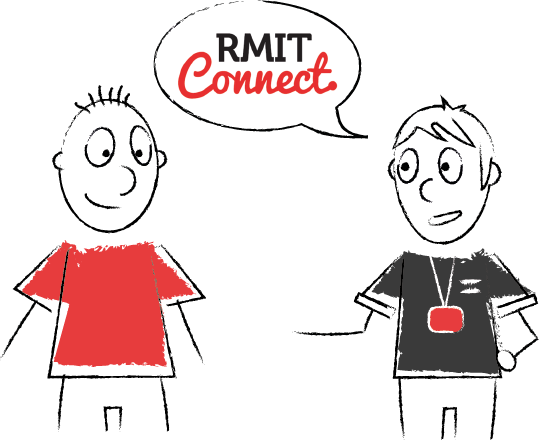Learning shock
Learning

University education in Australia is different from secondary, vocational and some other university experiences. Students are often unaware that there are new genres, tasks and methodologies for tertiary learning. They may experience 'learning shock', including confusion and anxiety, as they adjust to a new learning culture.
Teaching
We are interacting with groups of individuals who experience our teaching through a variety of cultural, generational and disciplinary filters. We need a range of strategies to support students as they transition to RMIT’s academic and professional culture.
Many RMIT teachers have found that simple, welcoming actions can make transitioning students feel that they belong to a learning community.
A friendly and approachable lecturer, who smiles at the students as they enter the classroom, can really make students feel welcome and that they belong.
Learning students' names helps them feel that they belong and are connected to the class. Taking a photo of students on the first day and writing their name on it helps me learn their names quickly.
On day one, I ask students to write their name on a piece of paper for the first few classes, this helps me use their names and learn them quickly.
Have students from various student associations make a short presentation in lectures.
It is important to make international students feel welcome. Let them know that cultural diversity brings a depth and richness to the classroom that is valued.
Send a group email at start of semester so students have your email address and know they can contact you with questions, difficulties etc.
With thanks to: Kirsten Balding, Dr. Nick Bardell, Peter Burke, Sanjay D’souza, Dr. Margaret Heffernan, Dr. Meredith Tharapos and Renee Ugazio.

Familiarise yourself with the various support services available to all students at RMIT. Remind your students that the RMIT website and the "Arrival guide" resources are good places to start.
Use quick ice breaker activities to get students to meet each other. Short pair/groupwork activities can assist students to develop networks and friends within their course. A focus on course content also inducts students to the discipline they study. All of these activities follow the same pattern of pair/group discussion followed by teacher-led whole group discussion For example:
Introductory activities
- True/false activity. Give students a list of true/false statements. These could be about tertiary expectations. See Getting Started quiz or design a short quiz around introducing course content. Students discuss the statements in pairs or groups to be followed by a whole group discussion around results.
- How much do you know about... Introduce a topic by asking students to discuss in pairs or groups how much they know about a topic around course content. This is again followed by a whole group discussion. This is a good icebreaker to use at the beginning of a semester or at the beginning of a new topic.
Revision activities
- What are the three most important ideas/concepts from today's class or lecture? Pair/groupwork followed by whole group discussion.
- List 10 new words or terms that are important to know for this topic. This activity assists students to consolidate the language of the discipline. Pair/groupwork followed by whole group discussion.
Activity: Assumptions quiz
We sometimes make all sorts of assumptions about how ready our students are for tertiary study. Test your understanding of some of the common issues that students face by completing this short quiz. Respond to each question by clicking "True" or "False". Feedback and relevant resources are provided.
